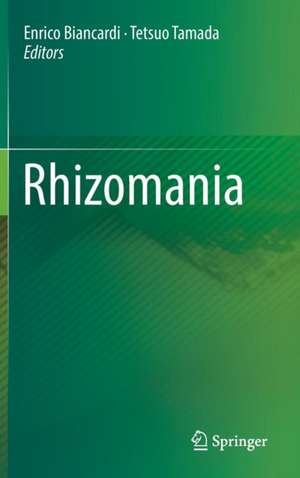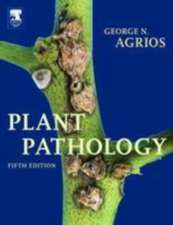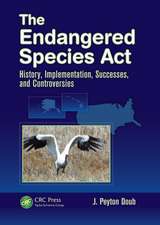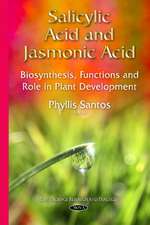Rhizomania
Editat de Enrico Biancardi, Tetsuo Tamadaen Limba Engleză Hardback – 30 sep 2016
| Toate formatele și edițiile | Preț | Express |
|---|---|---|
| Paperback (1) | 641.03 lei 6-8 săpt. | |
| Springer International Publishing – 14 iun 2018 | 641.03 lei 6-8 săpt. | |
| Hardback (1) | 647.27 lei 6-8 săpt. | |
| Springer International Publishing – 30 sep 2016 | 647.27 lei 6-8 săpt. |
Preț: 647.27 lei
Preț vechi: 761.49 lei
-15% Nou
Puncte Express: 971
Preț estimativ în valută:
123.89€ • 134.62$ • 104.14£
123.89€ • 134.62$ • 104.14£
Carte tipărită la comandă
Livrare economică 21 aprilie-05 mai
Preluare comenzi: 021 569.72.76
Specificații
ISBN-13: 9783319306766
ISBN-10: 3319306766
Pagini: 320
Ilustrații: XXV, 281 p. 61 illus., 36 illus. in color.
Dimensiuni: 155 x 235 x 19 mm
Greutate: 0.61 kg
Ediția:1st ed. 2016
Editura: Springer International Publishing
Colecția Springer
Locul publicării:Cham, Switzerland
ISBN-10: 3319306766
Pagini: 320
Ilustrații: XXV, 281 p. 61 illus., 36 illus. in color.
Dimensiuni: 155 x 235 x 19 mm
Greutate: 0.61 kg
Ediția:1st ed. 2016
Editura: Springer International Publishing
Colecția Springer
Locul publicării:Cham, Switzerland
Cuprins
1. introduction.- 2. Rhizomania: History and Current Status.- 3. The Causal Agents: Beet Necrotic Yellow Vein Virus.- 4. Molecular Biology and Replication of Beet Necrotic Yellow Vein Virus.- 5. Genetic Diversity of Beet Necrotic Yellow Vein virus.- 6. The Viral Vector Polymyxa betae.- 7. Ecology and Epidemiology.- 8. Control.- 9. Genetic Resistances.- 10. Engineering Transgenic Rhizomania Resistance.- 11. Breeding Methods.- 12 Assisted Selection.- 13 Perspective.
Notă biografică
Dr. Enrico Biancardi graduated in agronomy at the University of Bologna. At the Istituto Sperimentale per le Colture Industriali (formerly Stazione Sperimentale di Bieticoltura, Rovigo), he was devoted to, among other things, improving the processing quality of sugar beet in relation to the nitrogen content of the soil. Since 1977, his activity has been directed towards the breeding of resistances to cercospora leaf spot and, above all, to rhizomania. Selecting within the germplasm stored in the Institute, including hybrids made with Beta maritima collected along the Mediterranean coasts, several male-sterile lines and varieties have been developed, released, and utilized commercially. A significant part of the activity on Beta maritima was carried out in collaboration with the USDA-ARS Stations. He has authored and edited books, chapters, and around 150 publications. Retired in 2009, he currently collaborates with some American, English, and Italian breeders.
"Tetsuo Tamada was born in Hokkaido in 1941, is a graduate of Yamagata University, and obtained a PhD from Hokkaido University. He joined the Hokkaido Central Agricultural Experiment Station from 1964-1995 and was visiting scientist at the James Hutton Institute (formerly Scottish Crop Research Institute), UK, for 18 months (1979-1980). He accepted a position as Professor of Institute of Plant Science and Resources (formerly Research Institute for Bioresources), Okayama University from 1995-2007 and has been a Special Adviser of Agricultural Research Institute, Hokuren Federation of Agricultural Cooperatives, since 2013. His research interests include plant pathology, virology, and molecular biology. Prof. Tamada has published over 150 research papers and reviews on the topic of plant viruses".
"Tetsuo Tamada was born in Hokkaido in 1941, is a graduate of Yamagata University, and obtained a PhD from Hokkaido University. He joined the Hokkaido Central Agricultural Experiment Station from 1964-1995 and was visiting scientist at the James Hutton Institute (formerly Scottish Crop Research Institute), UK, for 18 months (1979-1980). He accepted a position as Professor of Institute of Plant Science and Resources (formerly Research Institute for Bioresources), Okayama University from 1995-2007 and has been a Special Adviser of Agricultural Research Institute, Hokuren Federation of Agricultural Cooperatives, since 2013. His research interests include plant pathology, virology, and molecular biology. Prof. Tamada has published over 150 research papers and reviews on the topic of plant viruses".
Textul de pe ultima copertă
Rhizomania is a relatively new and devastating disease affecting sugar beet. Around fifty years ago, it was recognized that the pathogenic agent is the virus, later named Beet necrotic yellow vein virus (BNYVV), vectored and inoculated by the soil-borne fungus Polymyxa betae. The diffusion of the disease is still ongoing today in every cultivated area and causes damage in sugar yield of sometimes more than 80%. It was soon understood that the unique, economically feasible means for limiting the damage was provided only by genetic resistances. In fact, the traditional management systems, including long crop rotations, nearly resulted without effects. The discovery of the causal agents and the release of the first resistant varieties are recalled by the researchers directly involved.
The introduction describes briefly the sugar beet crop, the more common diseases, and the damage caused by rhizomania. The following chapters discuss biological properties of the causal virus, BNYVV, and its vector, P. betae, and their interactions with the environment and the host-plant. In particular, the great advances in research of the molecular biology of BNYVV should be noteworthy, which have been established by a wide range of the most modern methods. Recent work focused on the genetic diversity and evolution of BNYVV is moving forward our understanding of the dramatic worldwide epidemics of rhizomania. Newly developed molecular techniques also lead to practical applications, such as quantification of inoculum in ecological and epidemiological research.
The knowledge of ecology and epidemiology of rhizomania is particularly useful to understand the means and practices able to limit or avoid its further diffusion. Some promising methods of biological control using coexisting and non-pathogenic organisms could potentially help improve the action of the not completely effective genetic resistances. This integrated protection would be valuable, especially in the even more frequent development of resistance–breaking strains in the BNYVV, where the known types of resistance, alone or in combination, seem to have lost part of their original ability to protect the crop. Therefore, further efforts will be needed to discover new traits likely still present in the wild species of the genus Beta. The availability of large collections of germplasm stored in the International Beta gene-banks should ensure the enhanced efficiency of genetic resistance by means of conventional and marker-assisted selection methods. Some almost immune transgenic varieties seem already to be waiting for release where and when it will be possible. The perspectives to not only reduce the current damages, but also to avoid further spread and noxious evolutions of the rhizomania agents are described.
The book provides a broad and comprehensive overview of the various aspects regarding the disease, including the more updated techniques for genome analysis. The outlook will be valuable for farmers, extension services, students, and researchers involved in lowering the effects of rhizomania, in order to ensure the future of sugar beet crop. The history of the discoveries that led to the almost complete control of the disease, also is a study case for those who are not directly interested in sugar beet crop.
Caracteristici
The book treats theoretical and practical aspects Reviews the developments obtained in around 50 years from the discovery Describes the recent and expected improvements of the genetic resistance One-of-a-kind text entirely devoted to Rhizomania






